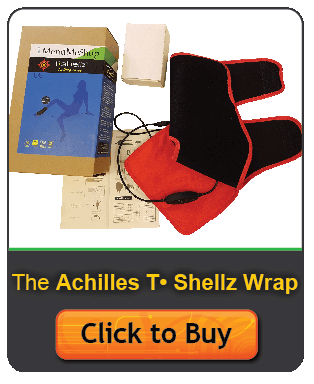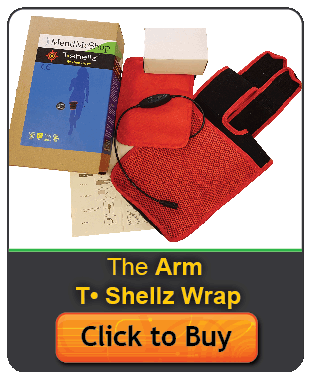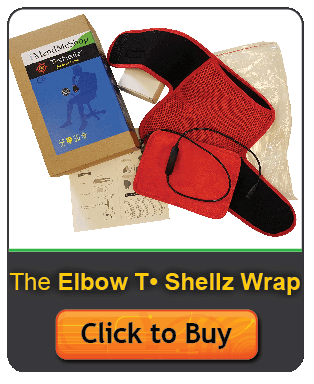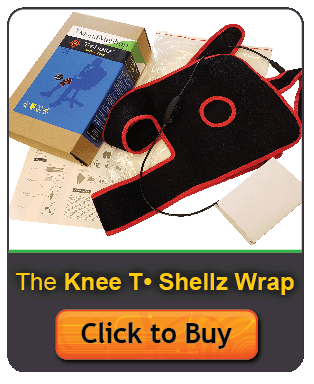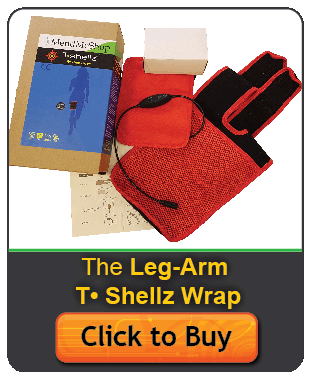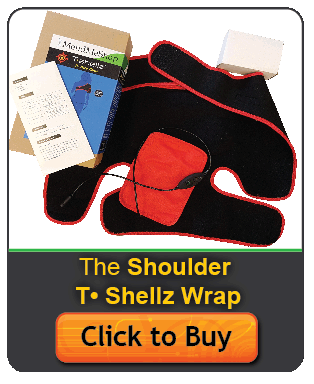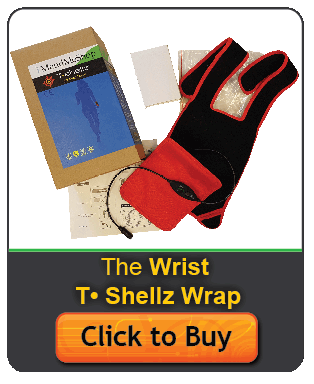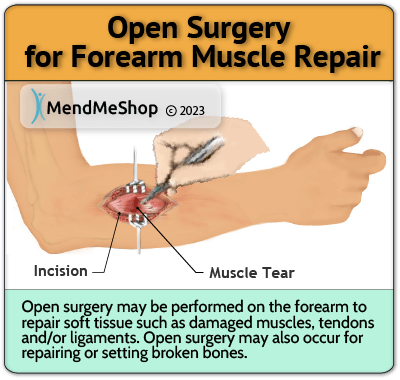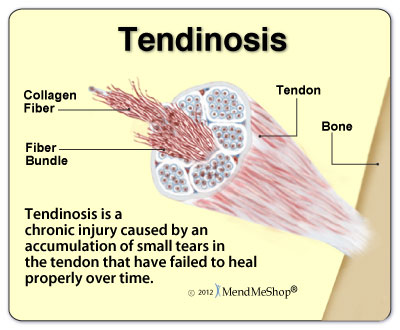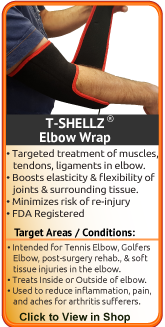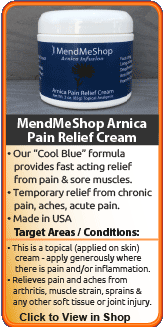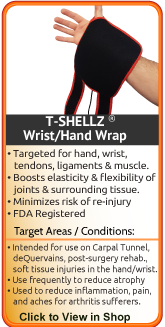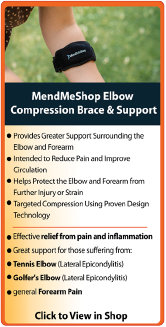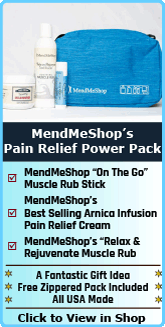|
| Forearm PainForearm pain manifests itself between the wrist and the elbow. The pain resulting from a forearm injury is experienced as tenderness, ache, tightness and often an inability to perform repetitive tasks. Most commonly, forearm pain results from repetitive stress such as tennis, golf and typing. Such symptoms of forearm pain can occur due to:
If you are dealing with forearm pain and are now looking for a way to deal with the pain and heal it completely, you need a diagnosis. The good news is not every elbow tendon injury or condition requires surgery. With most cases, you will notice a great improvement within 6 to 12 weeks - as long as you (1)stop doing whatever caused the issue to start with, (2) rest the area and (3) use conservative treatments to deal with inflammation and atrophy. However it can take many months in some chronic cases - even a year or more to return to normal. The more diligent you are with your treatment and rehabilitation, the faster you will see successful results. It is generally understood by doctors and surgeons, that surgery will introduce more scar tissue into the muscles and tendons in the forearm/elbow. This added scar tissue will be problematic, requiring PT and greater conservative treatment options post-surgery. If not dealt with properly, your soft tissue could end up in worse condition than before the surgery! This is why surgery is only performed as a last resort. Most doctors, physicians and orthopedic specialists will recommend conservative therapy for soft tissue injuries before considering surgery. Some conservative treatment methods recommended include:
 For acute (new or recent) elbow and forearm injuries that have the ability to heal on their own - your doctor may even suggest use of a removable sling. This can be helpful to prepare you for PT sessions and mobility exercises. However, prolonged use of a sling or long-term rest (restricted movement) without proper exercise or stretching can worsen your condition (and also affect shoulder mobility). If your arm remains completely immobilized and at constant rest, the edges of your soft tissue tear will begin to fill in with scar tissue as part of the healing process. You may also have on-going symptoms of pain, swelling, inflammation, and even poor blood flow circulation. What About Surgery?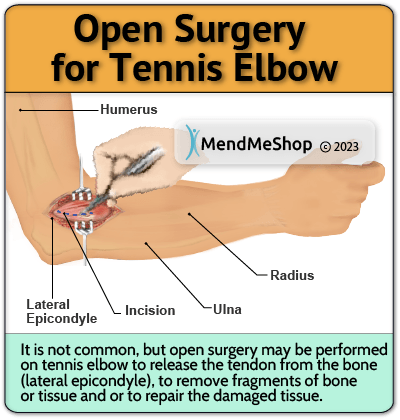 If the cause of your forearm pain is tennis elbow, know that 5% of all people suffering from Tennis Elbow may need to undergo surgery. The other 90 to 95% of all people will recover from their symptoms within 12 months of consistently using conservative treatments.(source: WebMD) If you are dealing with a detached or complete tear of your forearm muscle, surgery will be necessary. For minor strains & tears - before surgery is even considered, your physician will advise many months commitment to a conservative therapy program at least 6 consecutive months. Why so long? Your doctor will encourage you to stick to your at home treatments, your body has the ability to heal all on its own. In most cases time is needed for the tissue to form and be healthy enough to cope with our busy lifestyles. The long time to heal is because the elbow joint is very flexible and the skin is thin. This flexibility stretches soft tissue extensively and relatively low lack of blood flow makes damage to this soft tissue difficult to heal. The application of a Cold Compress or Ice Pack (when there is swelling), a TShellz Wrap® application (a couple times per day when there is no swelling), and PT will prepare your forearm/elbow for surgery. Strengthening your arm before surgery will give you the best chance for a successful recovery. Surgery is not the end of the journey with your recovery, but another new chapter that has it's own challenges. Your arm may not return to the complete functionality and range of motion that you enjoyed before surgery, but with a good rehabilitation you may get close. After surgery, you will undergo another 6-12 months of conservative therapy to help heal your arm. Learn more about Post-Surgery Rehabilitation and Recovery Here Supports and ExercisesYour doctor may encourage you to use a forearm cuff or brace. The brace or cuff gently adds compression to the muscles in the forearm to support the tendons in the elbow. Most physicians caution you in not wearing the elbow brace too frequently, as elbow tissue is then not allowed the time to heal. In some cases, prolonged use of a brace may cause increased secondary conditions such as pinched nerves and interruption to blood flow in the area. Restoring Flexibility and Strength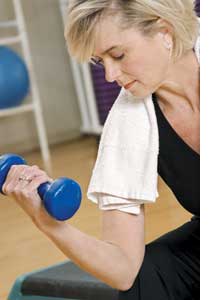 PT is a very helpful way to decrease pain in the soft tissue, restore strength to atrophied muscles and improve elbow, forearm and wrist strength and mobility. Your PT will start you on a program will be tailored for your injury (muscle strain/tear, tendinitis, tennis elbow, etc). Once your pain starts to reduce, a physical therapist (PT) will also set up an individualized arm and shoulder strengthening and stretching exercise program for you to perform at home or in the gym. This will be based on your needs and abilities, and will help you return to performing your normal routines. A trained PT will help to ensure your rehabilitation process is effective. For best, long term results use the TShellz Wrap® before undergoing PT to gain residual elongation and extensibility of collagen tissue. (reference: Chapter 9 of "Therapeutic Heat and Cold", 4th edition [amazon.com link] Ed. Justus F. Lehmann, M.D., Williams, and Wilkin) As you start to return to your activities, it is good to gauge how well you are using your arm in these activities to determine if you can decrease stress on the injured tissue. This may involve changing your technique for sports, for example using a two-handed backhand instead of a one-handed backhand in tennis, or using a properly weighted racquet (which will take stress off your forearm muscles). You may also need to change equipment you use at your job or at home to help you perform tasks more effectively and safely. If your job involves stresses to the forearm (construction, gas fitter, etc) you may opt to take time off temporarily. More frequent short breaks (and even stretches) at work are usually very helpful, as this allows your body a chance to relax and take some strain off your stressed soft tissue. It is important to speak with a medical professional or occupational therapist to get more information about proper equipment, procedures and tools necessary for the specific activity you participate in - or your office/work setting during normal daily life. Lifelong HealthThe best way to manage the health of your body is to understand the tools for a healthy lifestyle. Using proven conservative treatments, alternative therapies, protection, and self-management (diet, rest, exercise), you can proactively manage your own recovery. Your lifelong health depends on your commitment to living a healthy and safe lifestyle. 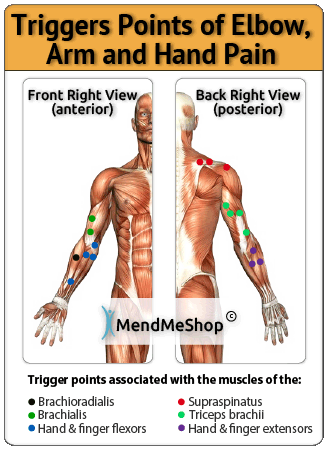 You may have to modify some of your activities or movements during your recovery to ensure the long term health of your wrist, forearm and elbow. Even if you are already feeling less pain and greater mobility, you need to continue with your treatment plan. Until your elbow is healed, you are still at risk for further damage. Keep in mind, the longer you wait to treat your Tennis Elbow injury, the greater the potential for re-injury or for permanent damage to occur. Chronic muscle strain and bursitis injuries usually arise after repeatedly ignoring your body's warning signs. Masking pain and immobility or continuing strenuous repetitive movements cause micro tears to form in your muscles and tendons. If your body is not given a chance to heal, scar tissue will form. This weak, inflexible tissue will cause chronic symptoms that include constant pain, functional restriction and weakening. Most cases of soft tissue injuries are completely treatable by conservative therapies. If you want to continue to enjoy your activities, sports, or have a physically demanding job, committing yourself to a conservative treatment routine, as soon as possible, will increase your chances of a full recovery. The more committed you are to your recovery, the faster you can return to your active lifestyle free from pain and immobility.Surgical TreatmentWhen Conservative Treatments FailIf you continue to suffer from persistent pain, weakness or recurring inflammation after trying conservative treatments recommended by your doctor, you may require a surgical option. The type of surgery you require will depend on the size, shape and location of your injury. This will be completed through day surgery; however it will require extensive rehabilitation utilizing the preliminary treatments noted above. PT and strengthening normally begin about 6 weeks after surgery. Your surgeon should provide a treatment plan to help you regain normal use as soon as possible. Speak with your physical about using the Elbow or Arm TShellz Wrap® for reducing your post-surgery recovery period. Arthroscopy on Forearm or ElbowArthroscopy is a minimally invasive surgery that involves making a small incision near the location of the problem and inserting a pencil-thin, fiber optic camera with a small lens and lighting system. Other incisions are made for surgical instruments that are typically used for removal of soft tissue, and stitching. The surgeon will take a look inside your joint to investigate all the soft tissues and bones. These images will then be transmitted to a TV monitor, which allow the doctor to make a diagnosis and/or perform the repair under video control. Your surgeon may repair tears or remove damaged tissue. In some cases of elbow surgery, they may have to cut the tendon at its attachment to the epicondyle bone and remove a small portion of the bone to increase blood flow to the area. (good blood flow is very important for healing and healthy soft tissue over the long term) Afterwards, sutures (stitches and/or anchors that hold the tissue together after they have been severed) can be used to attach the tendon to the bone or attach torn muscles back together. At the end of surgery, your incisions are closed, a dressing is applied, and your arm is placed in a splint. There are always some risks associated with any surgery, which include but are not limited to possible infection, allergic reaction to medications, and damage to surrounding nerves or blood vessels. However, modern techniques have significantly minimized the occurrence of these problems. Tenderness, pain, stiffness and weakness are very common after surgery, but with proper rehabilitation these should diminish. Although surgery is often successful at repairing any damage and/or relieving pain, it does not necessarily return strength to your elbow or forearm. That is why a strong commitment to rehabilitation is essential. Healing and recovery time is generally dependent on the extent of your injury, your age, pre-injury level of function, and your commitment to rehabilitation. Know that if conservative treatments are the right option for you, then consider dealing with your therapy seriously by incorporating the use of a TShellz Wrap®. Forearm and Elbow Injuries Can Easily Lead to Other Conditions and Injuries.Every time we use our injured elbow and forearm- damaged and swollen tendons and muscle tissue move; when they are inflamed, every movement hurts. With injured tissue, pain happens - sometimes a LOT of pain, so we try not to move it. So, when doing something we need to use our arm for (getting dressed, driving, holding a nail-gun, talking on the phone), we start to use the shoulder and wrist more. If we can, we use our other arm instead even though it is inconvenient. A couple days later (after purposefully avoiding movement of our elbow), the pain has gone down (as well as the swelling) and this is where the trouble begins! The pain disappeared with the swelling but we still aren't fully healed! Not knowing this, we start using our arm normally again and then the injury swells up again like it did before - all because the injury wasn't fully healed in the first place. We continually re-injure our elbow and forearm through daily activities and now this injury has become chronic, continuing to worsen week after week. Eventually, we use the other arm more and more. This is why the elbow and forearm on the opposite arm start to hurt - they are being overused now. Soon, aches and pain can become commonplace in both arms and elbows - all as a result of the original elbow/forearm injury and the body's instinctive nature to "protect" it - all because the injury wasn't fully healed in the first place! Muscle imbalances result, placing tension on bone and softer tissues - leading to a misalignment within the upper body. The extra stress on the opposite side of the body will also result in weakness and fatigue - increasing the chances they can eventually be injured or gradually degenerate. This is a textbook example of how you get an overcompensation injury. In some cases, PTs warn that overcompensation can be very dangerous; when dealing with the shoulder, hips and knees - overcompensation can affect gait or alignment on a permanent basis. An injury to one forearm or elbow can easily lead to straining in other areas, making an overall recovery hard to initiate. For example, a serious muscle strain in the right forearm can often lead to over-straining of the left forearm. Most commonly, the initial injury occurs on the dominant side, so the risk of straining the other (weaker) side increases. The longer the injury (and corresponding pain) persists, the greater the chance that you will sustain more strain from overcompensation, eventually leading to issues in those areas as well. To minimize potential secondary injuries, know that it is important to deal with your tendon/muscle injury quickly and completely. Truly, forearm and elbow injuries can become a vicious cycle - which is why it is absolutely critical to focus on methods that improve and strengthen the injured tissues in a timely manner. The faster you truly heal, the less chance you have of sinking into a downward spiral of re-injury, scar tissue growth and overcompensation injuries. Okay, So I Have a Painful Forearm Strain Injury...What Should I Do Now?Stage 1: If the injury is very recent - use a good quality cold pack and Arnica Pain Relief Cream.Note: If you are suffering from a tendinosis injury that has been going on for awhile, then skip the cold treatment as inflammation will be minimal. Anytime you are experiencing significant pain, you may find our Arnica Infusion Pain Relief Cream to be quite helpful. 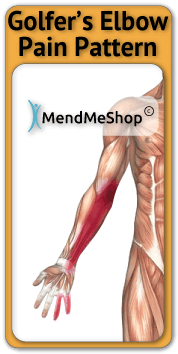 If you are experiencing pain and swelling in the very early stages of the injury (first 48 to 72 hours), the first step in a conservative treatment protocol would be to focus on reducing the discomfort by applying a quality cold pack to the injured elbow/forearm along with a high quality pain relief cream such as our Arnica Infusion Cream. Not only will you use your cold pack for the first 48 to 72 hours after the injury, but you should also use it during other stages of the healing process. Some examples include...
Having a Cold Compress or Ice Pack available at home to use if and when the need arises is helpful. Many of you already do so. Often, too many people over-focus on cold while ignoring the most critical aspect to healing - nourishing injured tissue with a strong blood flow - the body's healing capability is generally dependent on blood flow.. This leads to the most important recommendation... Stage 2: Focus on Increasing Blood Flow To The Injured Tissue - As This is How Soft Tissue Heals For the Long-TermEven though the concept is simple, improving blood flow to injured tissues can be difficult. Traditional methods require your muscle to move to promote blood flow (exercise), but that same motion that promotes blood flow can at times lead to making your pain and condition worse.
Most people we deal with tell us these scenarios have happened to them many times in the past. Perhaps it has already happened to you. Promoting blood flow within a muscle or soft tissue injury to help the body heal itself is a concept that has been utilized for centuries. This is where the focus has to be if you are seeking long-term improvement. Oxygen and nutrients, carried within the blood, are critical for the body to heal itself. Without proper blood flow, recovering from an injury or condition will be delayed...sometimes for a very long period of time. The real challenge is how do you promote blood flow to muscles and tendons in the forearm, wrist and elbow without causing further injury? This goal is further complicated by the fact that your arms are involved in lot of strenuous and/or repetitive movements performed each day. An injury that often leads to straining in other areas will make an overall recovery hard to initiate. People tend to "chase the pain", meaning they only focus on treating an area that is actively painful, while not taking into account the fact they other areas of the body will be overcompensating...eventually leading to issues in those areas as well. Heat energy generated by the TShellz Wraps® operate by increasing blood flow in our injured soft tissue. This means ligaments, muscles, and tendons. The objective of the TShellz Wrap® is to increase blood flow in these targeted areas, resulting in relaxation of the vessel walls. The vessels then gently expand, allowing for more nutrient rich blood flow along with extra oxygen to reach the damaged tissues. Plus, the enhanced blood flow helps in flushing waste and fluid build-up from the injury site - further enhancing the ability of the body to heal. With a TShellz Wrap® application, more blood begins to flow effectively to soft tissue within the body - for the length of the treatment and a short duration thereafter. Deep tissue needs the extra blood flow to heal as it is through the blood the body carries the oxygen and nutrients needed for proper and long-term healing. Now, on to recommendation number two in the journey to heal your injured forearm... The Arm TShellz Wrap® - A Healthy Forearm For The Long TermThe best option we came across in our research to accomplish effective blood flow to soft tissue in the treatment area at home is the TShellz Wrap®. Use of this device results in an increase of blood flow within the treatment area - all in a non-invasive manner. Have you seen what happens when you add water to a flower wilted from drought? In essence, your injured elbow is much like a "wilted" flower; your body wants to heal its injury, but needs lots of nutrients to do it. Blood brings life to your tissue by delivering healing nutrients and oxygen that are vital for their growth and survival. In addition, the blood carries away toxins and waste cleaning the area and healing it faster. Without a good supply of blood, your elbow simply won't heal properly. Using a TShellz Wrap® will not expose you to the risk of causing further harm to soft tissue like you can when using rigorous exercise. The Elbow TShellz Wrap® accomplishes the goal of enhanced blood flow without the need for intensive exercise and as such reduces your risk of re-injury. Who Should Use the Elbow TShellz Wrap®We recommend the use of an Elbow TShellz Wrap®:
Increased Blood Circulation = Increased Healing CapabilityTShellz Wraps® contain a unique Carbon Fiber Energy Pad which is flexible and will shape to conform to your body. This Energy Pad emits a uniform wave of perfectly safe energy over its entire surface. This energy is absorbed by soft tissue in the treatment area, opening blood vessels, resulting in an increase in blood flow. Increased blood circulation is what your body needs to maximize its cabability of healing soft tissue and this is why we recommend the TShellz Wrap®. The Elbow TShellz Wrap® is an FDA Registered Medical Device and is suitable for use in therapeutic clinics and FROM HOME. It is completely safe for people and patients to use for themselves. The technology found in a TShellz Wrap® has been used for decades in the worlds of professional and amateur sports - a contributing factor as to why athletes seem to recover from injuries so quickly. Have you ever wondered by an athlete can return to activity after 4 or 5 weeks following an elbow or forearm injury - while your average person takes much longer to return back to normal? The secret isn't really that much of a secret - it involves consistent treatments (meaning multiple times a day) using a treatment like the TShellz Wrap® to stimulate blood flow to the injured tissues. Most athletes have the luxury of using in-house facilities many times per day. How many us can afford the time and money to visit a clinic multiple times a day? Very few indeed. This is how you can gain some of the advantages that athletes enjoy in their injury recovery - by using a device like the Elbow TShellz Wrap® two or three times a day on a consistent basis. Consistent Treatments = Consistent And Long Term ImprovementWhat Else Makes the Elbow TShellz Wrap® So Special?We believe the TShellz Wrap® to be one of the most effective home treatments to increase localized blood flow to soft tissue in and around the treatment area. We can promise that you will receive a product that is designed to be safe and does what it is supposed to do... reduce pain (as stated in "Therapeutic Heat and Cold", 4th edition. - Ed. Justus F. Lehmann, M.D., Williams, and Wilkin) temporarily increase length & flexibility of soft tissue (as stated in "Therapeutic Heat and Cold", 4th edition. - Ed. Justus F. Lehmann, M.D., Williams, and Wilkin) and aid your body in recovering from tendon, muscle and other soft tissue injuries via enhanced blood flow. The unit plugs into a standard wall outlet to get its power. The nice thing about the power supply is that the same unit can be used in North America and overseas as well. It has the capability to operate between 110v and 230v. The TShellz Wrap® has a special signal controller that can be set for 3 different power levels of application (3=High, 2=Medium, 1=Low). The cord is long enough that you can sit or lie comfortably and watch TV, read or surf the net while you're using it. Treatments are max 30 minutes in duration and the device can be worn over clothing. This allows you to use the device at work, at home, or really anywhere you have access to an electrical outlet. A Recap of the Benefits of the Arm/Leg TShellz Wrap®..
When Should I Use My TShellz Wrap During the Day?The most common question we receive from individuals prior to purchasing is - how many times a day should I be using my wrap(s) and when should I be using them? While treatment plans will differ for each individual and their specific injury, there are general guidelines that should be adhered to.
The TShellz Wrap® would then be used:
Stage 3 - In Between Treatments With TShellz Wrap®, Apply Our New Fast Acting Pain Relief Cream Called ARNICA INFUSIONDealing with aches and pains affecting the foot, ankle, leg, knee, hamstring, hip, back, arm, shoulder, elbow, wrist, or hand? If so, then applying the Arnica Infusion to any of these targeted areas will bring about fast relief from the pain and sore tissues. Simply apply a small amount of cream to the body and moments later, you will experience a soothing and comforting sensation over the area. Arnica Infusion is specially designed to relieve pain due to sore muscles and joints associated with arthritis, backaches, sprains, strains, and bruises. No matter if you are dealing with an acute injury, chronic pain, or a general "flare-up" - you will experience fast relief from pain and inflammation. This is a product that many of our current MendMeShop customers asked us to develop. So we focused our time and resources over the past few years and came up, with we believe, will be one of more effective, fast acting, topical pain relief creams on the market. You are likely familiar with some of the standard topical agents on the market as most of our customers use them. The are mass marketed and even found in most department stores now. Well, we are here to say that Arnica Infusion goes many steps beyond what they offer. Made in the USA at an FDA registered manufacturing facility, you can be assured that Arnica Infusion is both safe and effective. We only source top grade ingredients while implementing strict quality control checks during every step of the production process. Expect the same high quality that MendMeShop customers have been accustomed to since we started the company in 2005. The "Cool Blue" formula is the perfect balance between the smooth application of a cream and the effective absorbing factor of a gel. It is not too thick and not too thin - just the right texture. Best of all, it feels very nice on the skin! Each application of Arnica Infusion feels so comforting and soothing, we are certain it will become an item you will not want to live without. Arnica Infusion IngredientsThe Arnica Infusion formula is based on a combination of scientific research and the use of high quality ingredients. The properties within the formula were chosen for their pain relief, anti-inflammatory, and soothing qualities. The acting ingredients within the formula include ones many of us are familiar with; along with ones that have not received a lot of publicity (only in research circles). Extensive testing resulted in a blending of ingredients that provides the most synergistic of benefits. The notable ingredients in the Arnica Infusion formula include:
Extensive quality control procedures during the manufacturing process ensure the ingredients and final product are both safe and effective. We would not stake our reputation on anything but the best. When Do I Apply the Arnica Infusion?While At WorkApply Arnica Infusion at work to help reduce acute discomfort associated with overuse of muscles and joints. No matter if you are in a physical demanding job or work within an office environment, you will be placing stress on different parts of the body and aches and pains will result. Before Or After Work, Sports, & ActivityIf you suffer from a sprained ligament, pulled muscle, strained tendon, or even bruising - apply Arnica Infusion for quick relief of the pain. Chronic Pain SufferingApplication of Arnica Infusion can be done up to a maximum of 4 times per day on a consistent basis to help bring about relief from various pains and aches. In-between Treatments With the TShellz Wraps®Follow up your T-Shellz and Cold treatments with an application of Arnica Infusion. Combine the pain relieving benefits of Arnica Infusion along with the healing benefits of the wraps to make your recovery go much more smoothly. Do not apply Arnica Infusion within a 2 hour timespan before a TShellz Wrap® treatment. Whether you decide to use the Arnica Infusion in conjunction with the TShellz Wrap® and other treatments - or if you decide to use the cream as a stand-alone product - you will not be disappointed with the results. We guarantee it. A Note On OverCompensationAs you are here, it is probable that you already know substantial soft tissue strains in the elbow and forearm do not just disappear. Over time, they usually wreak havoc on your shoulder & wrist due to lack of movement and over-compensation. It will also wreak havoc on your opposite arm due to overcompensation. Recovery takes a longer time for such chronic (long term) injuries, but proper healing is essential to regain strength and get you back to the activities you enjoy.The longer your injury endures, the greater the risk of running into serious overcompensation injuries. To Stop Re-Injury & Reduce the Risk of a More Serious Overcompensation Injury, You Need to Heal Quickly & Completely! Anyone in need of rapid recovery and complete healing must consider a comprehensive treatment plan that includes an effective means to minimize swelling and inflammation yet also stimulate healing and tissue elasticity. We have found no better set of tools that can be used at home than this: Conservative Treatment Tools Our Clients Have Used to Help |

